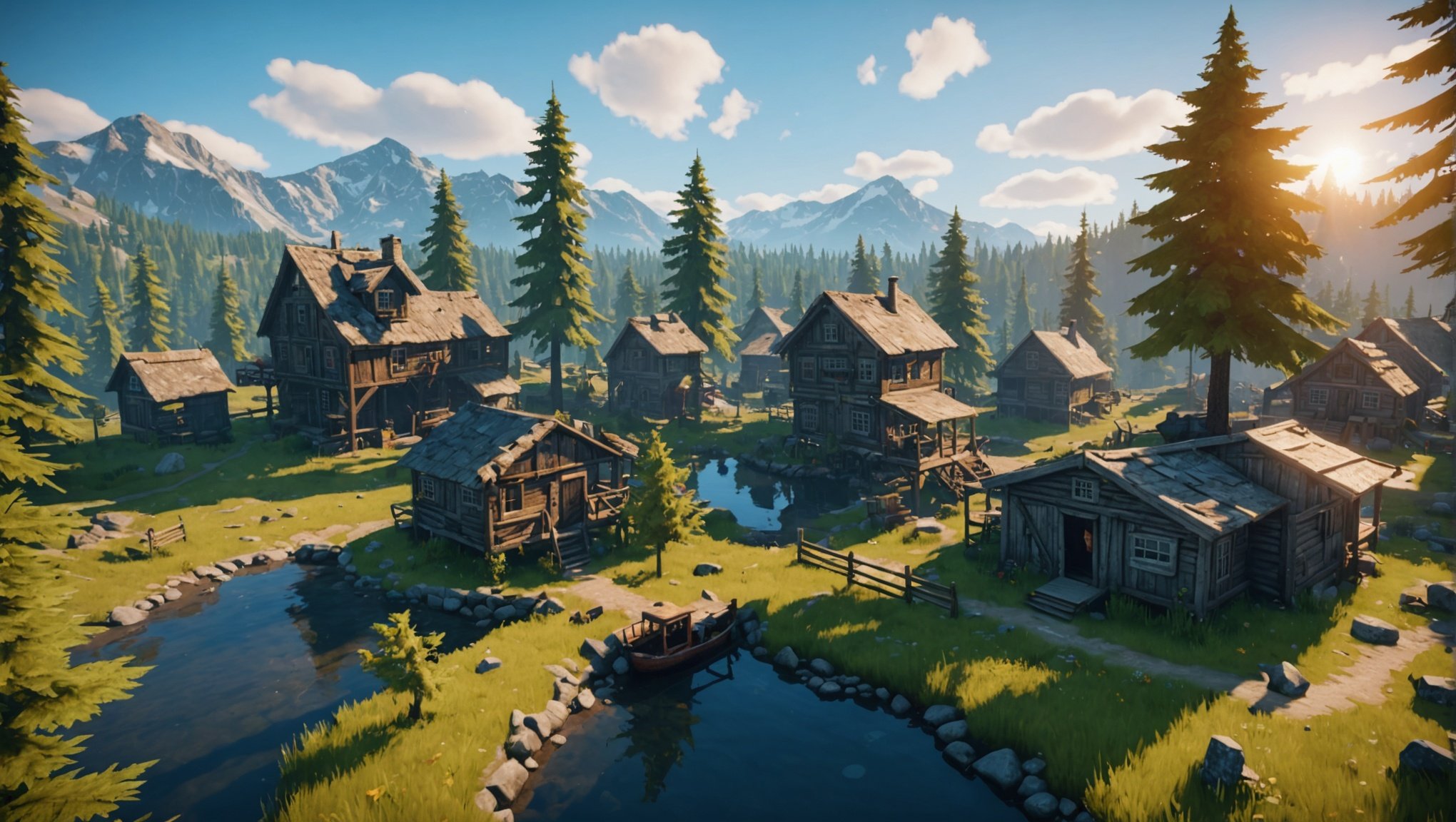Maximizing Fun: How Developers Can Enhance Crafting Systems in Survival Games with Real-World Physics
The Evolution of Crafting in Survival Games
Crafting systems have been a cornerstone of survival games for years, offering players a sense of accomplishment and immersion as they gather resources, craft tools, and build their way to survival. However, as the gaming landscape evolves, so too must the crafting mechanics to keep players engaged and entertained. One of the most promising ways to enhance these systems is by incorporating real-world physics.
The Role of Real-World Physics
Real-world physics can add a layer of realism and complexity to crafting systems, making the gaming experience more authentic and engaging. For instance, in games like Rust, players must manage resources and build structures that adhere to basic physical principles, such as gravity and structural integrity. This not only makes the game more challenging but also more rewarding as players see their creations stand the test of time and environment.
Also to discover : Transforming Diving Simulations: Unleashing AI for Hyper-Realistic Underwater Physics
Designing Crafting Systems with Real-World Physics
When designing a crafting system that incorporates real-world physics, several key elements must be considered.
Resource Gathering and Processing
Resource gathering is the foundation of any crafting system. However, by adding real-world physics, developers can make this process more nuanced. For example, in Medieval Dynasty, players must hunt, farm, and process resources in a way that simulates real-world activities. This could involve using tools that behave according to physical laws, such as axes that require proper swing mechanics to fell trees efficiently.
Also read : Enhancing Escape Room Experiences: Utilizing AI to Tailor Puzzle Difficulty in Real-Time
Key Considerations for Resource Gathering:
- Tool Mechanics: Implement tools that require specific actions to function effectively, such as swinging an axe or hammering nails.
- Resource Properties: Assign physical properties to resources, like weight, density, and durability, to make gathering and processing more realistic.
- Environmental Impact: Consider how the environment affects resource gathering, such as weather conditions or terrain difficulties.
Crafting and Building
Crafting and building are where real-world physics can truly shine. Games like Palworld allow players to build structures and use creatures (Pals) in a way that simulates real-world labor and resource management. Here, the Pals can be used to automate tasks, but their physical capabilities and limitations must be considered.
Key Considerations for Crafting and Building:
- Structural Integrity: Ensure that buildings and structures adhere to basic physical principles, such as gravity and load distribution.
- Material Properties: Assign realistic properties to materials, such as strength, flexibility, and weight, to affect how they behave in different situations.
- Automation: Allow players to automate tasks using creatures or machines that have their own physical limitations and capabilities.
Enhancing the Gaming Experience
Incorporating real-world physics into crafting systems can significantly enhance the gaming experience in several ways.
Increased Realism and Immersion
Real-world physics adds a layer of realism that can deeply immerse players in the game world. For example, in Fallout 4 Survival Mode, the harsh survival conditions, including hunger, thirst, and health management, are made more realistic by the physical consequences of neglecting these needs. This makes the game feel more grounded and challenging.
Player Testimonial:
“Playing Fallout 4 Survival Mode feels like a whole different game. The physical challenges make every decision feel critical, and the sense of accomplishment when you survive a tough situation is unparalleled.” – Fallout 4 Player
Improved Player Engagement
Games that incorporate real-world physics often require players to think creatively and strategically. In Rust, players must build structures that can withstand environmental hazards and other players’ attacks, which encourages a deep level of engagement and problem-solving.
Key Engagement Factors:
- Challenge and Reward: Players are challenged to build and maintain structures that adhere to physical laws, making successes more rewarding.
- Strategy and Planning: Players must plan and strategize their builds, taking into account physical limitations and potential risks.
- Community Interaction: Players can share tips and strategies on how to build effectively, fostering a sense of community.
Technical Implementation
Implementing real-world physics in game development involves several technical considerations.
Microservices Architecture
For games that require complex physics simulations, a microservices architecture can be beneficial. This approach, as seen in the development of games like Star Wars Jedi, allows different aspects of the game, such as physics simulations, to be handled by separate services. This ensures that the game can scale efficiently and maintain performance under varying loads.
Technical Benefits:
- Scalability: Microservices allow for individual components to be scaled independently, ensuring that the game can handle peak loads.
- Performance: By distributing tasks across multiple services, the game can maintain smooth performance even with complex physics simulations.
- Maintenance: Issues can be isolated and resolved more easily, reducing downtime and improving overall game stability.
Load Balancing and CDNs
To ensure that the game performs well globally, load balancing and Content Delivery Networks (CDNs) are crucial. These tools distribute traffic across different servers and cache static assets closer to users, reducing latency and load times.
Load Balancing and CDN Benefits:
- Global Performance: Load balancers ensure that players connect to the nearest server, reducing latency and improving overall performance.
- Resource Optimization: CDNs cache static assets, reducing the load on main servers and minimizing latency for players.
Examples of Successful Implementation
Several games have successfully implemented real-world physics in their crafting systems, offering valuable lessons for developers.
Rust
Rust is a prime example of a game that heavily incorporates real-world physics into its crafting and building mechanics. Players must gather resources, craft tools, and build structures that can withstand environmental hazards and other players’ attacks. The game’s focus on realism makes it highly engaging and challenging.
Key Features:
- Resource Gathering: Players must manage resources in a way that simulates real-world activities.
- Building Mechanics: Structures must adhere to physical principles, such as gravity and structural integrity.
- Player Interaction: Players can interact with each other’s structures, adding a social and competitive layer to the game.
Medieval Dynasty
Medieval Dynasty combines survival mechanics with a deep crafting system that simulates real-world activities. Players must hunt, farm, and process resources in a way that feels authentic and immersive. The game’s focus on realism and historical accuracy makes it a standout in the survival genre.
Key Features:
- Resource Processing: Players must process resources in a way that simulates real-world activities, such as tanning hides or smelting metal.
- Building and Farming: Players can build structures and manage farms, taking into account physical properties and environmental factors.
- Historical Accuracy: The game’s historical setting and accurate depiction of medieval life add to its immersive nature.
Practical Insights and Actionable Advice
For developers looking to enhance their crafting systems with real-world physics, here are some practical insights and actionable advice:
Start with Simulations
Begin by simulating basic physical principles in your game. This could involve simple mechanics like gravity or more complex simulations like fluid dynamics.
Simulation Tips:
- Keep it Simple: Start with basic simulations and gradually add complexity.
- Test Thoroughly: Ensure that your simulations are accurate and consistent.
- Player Feedback: Gather feedback from players to refine and improve your simulations.
Use Real-World Data
Use real-world data to inform your game’s physics simulations. This could involve studying how materials behave in different conditions or how structures respond to environmental stresses.
Data-Driven Design:
- Research: Conduct thorough research on the physical properties of materials and structures.
- Consult Experts: Collaborate with experts in relevant fields to ensure accuracy.
- Iterate: Continuously iterate and refine your simulations based on real-world data.
Balance Realism and Fun
While realism is important, it’s equally crucial to ensure that the game remains fun and engaging. Balance realism with gameplay mechanics that are enjoyable and rewarding.
Balancing Realism and Fun:
- Player Experience: Prioritize the player’s experience and ensure that realism does not come at the cost of fun.
- Feedback Loops: Implement feedback loops to help players understand the consequences of their actions.
- Rewards: Ensure that players are rewarded for their efforts, even if they fail, to maintain engagement.
Incorporating real-world physics into crafting systems in survival games can significantly enhance the gaming experience. By adding realism, complexity, and authenticity, developers can create games that are more immersive, engaging, and rewarding. Whether it’s through resource gathering, crafting, or building, real-world physics can transform a good game into a great one.
Final Thoughts:
“Games that incorporate real-world physics are not just about survival; they’re about creating a world that feels alive and responsive. As developers, our role is to craft an experience that challenges and rewards players in equal measure. By using real-world physics, we can create games that are not just fun but also deeply satisfying.” – Game Developer
Table: Comparison of Crafting Systems in Survival Games
| Game | Resource Gathering | Crafting Mechanics | Building Mechanics | Real-World Physics |
|---|---|---|---|---|
| Rust | Tool-based | Material properties | Structural integrity | Yes |
| Medieval Dynasty | Process-based | Historical accuracy | Farming and building | Yes |
| Palworld | Creature-based | Automation | Resource production | Yes |
| Fallout 4 Survival Mode | Basic survival needs | Realistic survival | Environmental impact | Yes |
| Craftopia | Mixed (manual and automated) | Crafting and building | Environmental impact | Partially |
Detailed Bullet Point List: Key Features of Enhanced Crafting Systems
- Resource Gathering:
- Tool mechanics that simulate real-world activities
- Resource properties that affect gathering and processing
- Environmental impact on resource availability
- Crafting Mechanics:
- Material properties that affect crafting outcomes
- Realistic processing times and methods
- Automation options using creatures or machines
- Building Mechanics:
- Structural integrity based on physical principles
- Material properties affecting building durability
- Environmental impact on building stability
- Real-World Physics:
- Simulations of gravity, fluid dynamics, and other physical principles
- Real-world data informing game mechanics
- Balance between realism and gameplay fun
By integrating these features, developers can create crafting systems that are not only engaging but also deeply immersive and realistic, enhancing the overall gaming experience for players.












